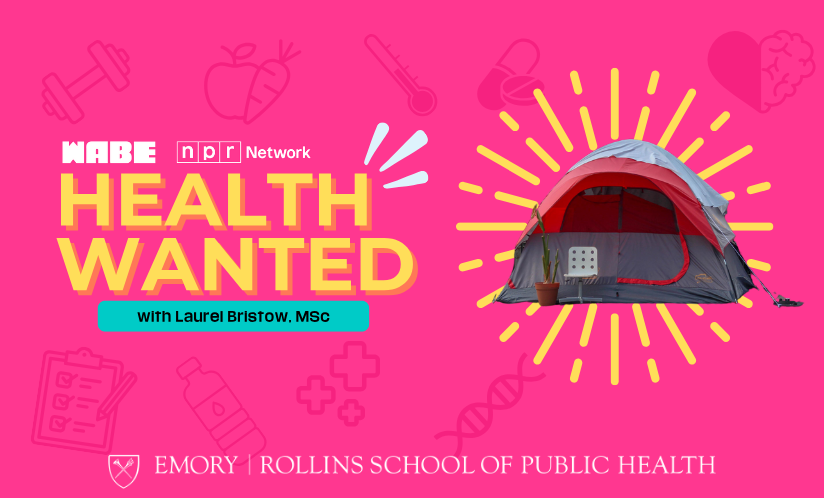Health Wanted: Health of the Unhoused

The Episode
The topic: Homelessness has been rising in the U.S., and when people end up on the street, their health is at risk. This week on Health Wanted, host Laurel Bristow and guest Kelly Doran, MD, talk about housing as health care and the policies that can help lift people out of poverty.
The takeaway:
- There are a lot of systemic, societal factors that increase the risk of someone losing their housing stability. These include the cost of housing, available housing units, minimum wage, and eligibility for government housing assistance. Despite popular belief, substance use disorders are not a major contributor. Only 16.5% of the U.S. unhoused population experience chronic substance misuse.
- The risk of poor health and homelessness is a two-way street. Those who face housing insecurity are at greater risk of developing health issues, and sometimes the cost of chronic health issues can result in housing insecurity. Chronic stress from homelessness also makes people more vulnerable to health issues and substance use. Unhoused people also have less access to health care, which puts them at greater risk for complications from health conditions like diabetes.
- Shelters can also pose health risks. Many are designed to maximize occupancy with bunk beds that aren’t accessible to disabled or older people. Living in an enclosed space with a number of other people also increases the risk for transmission of respiratory diseases such as flu, COVID or TB.
- While addressing the root causes of homelessness (namely, income inequality and housing) would work to reduce the unhoused population, state and local governments seem to be increasingly taking an “out of sight, out of mind” approach. Cities use hostile architecture to prevent people from being able to sleep in public, pass laws that make it illegal to sleep outside and even for others to feed unhoused people, and clear encampments.
The Listener Questions
Will Trump be able to lower prescription drug costs?
There is no question that the United States pays way too much for prescription drugs. We desperately need reform and cheaper options, but there doesn’t seem to be a plan behind this executive order beyond “I want this to happen in 30 days.” I also have a lot of questions about the things he’s said.
The way our current system is set up, pharmaceutical companies make a lot of profit, and I worry that if we change things and it cuts into that profit, they will be less motivated to make newer and better drugs.
Trump claimed that the reason we pay so much is because other countries pay so little, and that’s not really true.
The real reason other countries have lower prices is that they have nationalized health care, so instead of all these different groups and pharmacies negotiating prices with drug companies, it’s one government agency doing it. So, they have the power to say “you can work with us on this price, or you get zero customers in this country.”
I’m not sure how trump would get those countries to pay more, as he is not their president, and I don’t know how he would enforce making companies here charge more.
Another aspect of the plan was to potentially import drugs that are manufactured in other parts of the world. My question with that is, who will be responsible for checking the safety and quality of those products when the agencies responsible for that kind of inspection have been crippled by reduction in force cuts?
I would love to reduce drug prices in the U.S., but I think this plan needs a bit more thought before I believe it’s feasible.
What is hydroxyapatite?
If you’ve never heard the term before, hydroxyapatite (HAP) is gaining attention as basically the fluoride alternative for re-mineralization of tooth enamel.
Our tooth enamel is composed primarily of phosphate ions and calcium ions. It’s called hydroxyapatite.
We get cavities because bacteria in our mouths convert carbohydrates into, basically, acid. And that acidic environment eats away at our tooth enamel. When you use fluoride products or have systemic fluoride in your body, the fluoride ions interact with the phosphate and calcium and create fluorapatite.
This compound not only remineralizes your teeth, repairing the damage of an acidic mouth, but it also makes your teeth more resistant to an acidic environment. It rebuilds them stronger.
HAP toothpaste, on the other hand, contains the same chemical composition of your tooth enamel, so it’s easily taken up by your teeth to remineralize them. Studies have shown that both fluoride toothpaste and HAP toothpaste have similar success at remineralizing teeth, but that fluoride makes your teeth more resistant to future acid attacks.
HAP also seems to be a good option for people who have tooth sensitivity.
If someone absolutely doesn’t want to use fluoride, or lives in an area with naturally high water fluoridation, HAP is a fine alternative. It is, however, significantly more expensive than fluoride, which makes it prohibitive for a lot of people.
A lot of people on social media like to talk about how safe it is, and it’s probably totally fine, but it also hasn’t been researched as much as fluoride. It might have side effects we’re not aware of yet, so that’s just something to consider.
Catch all the listener questions and Laurel’s answers on the full episode of Health Wanted by:
- Streaming at org or the WABE app
- Subscribing on Apple or Spotify
- Watching on WABE's YouTube channel
Show Notes
Want to dive deeper into this week's topic? Find Laurel's sources here.
- Brink of Homelessness
- 2024 Acorns Money Matters Report™
- More Older Adults are Homeless—What Can Be Done to Help this Vulnerable Population with Unique Needs
- Substance Abuse and Homelessness
- How Stable Housing Supports Recovery from Substance Use Disorders
- How Common Is Illegal Drug Use Among People Who Are Homeless?
- High Housing Costs Are Consuming Household Incomes
- Homelessness Data & Trends
- A Shortage of Affordable Housing
- Prohibiting Discrimination Against Renters Using Housing Vouchers Improves Results
- How Many Houses Are in the US? Homelessness vs Housing Availability
- Medical Bankruptcy: Still Common Despite the Affordable Care Act
- Chronic Stress, Drug Use, and Vulnerability to Addiction
- Higher Rates of Homelessness are Associated with Increases in Mortality from Accidental Drug and Alcohol Poisonings
- The Association of Homelessness With Rates of Diabetes Complications: A Population-Based Cohort Study
- Homeless With a Heart Attack in America—A Double Whammy
- Health Care and Homelessness
- Kansas: TB Outbreak Is Largest in History. CDC: No It’s Not.
- Response to Isoniazid-Resistant Tuberculosis in Homeless Shelters, Georgia, USA, 2015–2017
- State of Homelessness: 2024 Edition
- The Disproportionate Impact of Climate Change on People Experiencing Homelessness
- Cold-Related Injuries
- Unconditional cash transfers reduce homelessness
- Miracle Money California
- How Stable Housing Supports Recovery from Substance Use Disorders
- Many more cities ban sleeping outside despite a lack of shelter space
- "Criminalizing the Samaritan": Why cities across the US are making it illegal to feed the homeless
- Newsom wants cities to force homeless Californians to move camp every 3 days
- Population-Level Health Effects of Involuntary Displacement of People Experiencing Unsheltered Homelessness Who Inject Drugs in US Cities
- Atlanta rethinks clearing homeless camps after a man is crushed inside his tent


